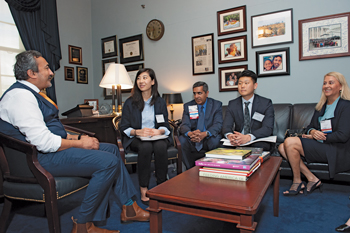The dilemma of breast density
Women are not getting the information they need to make decisions about breast density and mammography, while state legislators have jumped into the process.
It may sound like an insult or a joke, but the question “Are you dense?” has become a hot topic in women's health, Katrina Armstrong, MD, FACP, told attendees at Internal Medicine Meeting 2018.
There's even a website. “It's an extraordinary effort that has grown up to say that women are not getting the information they deserve about the density in their breasts,” said Dr. Armstrong, chair of the department of medicine at Massachusetts General Hospital in Boston.
Legislators have also gotten in on the action. Thirty states have laws about breast-density notification, and additional states have such legislation in process. “It really has swept the country in the past five to 10 years, with legislation now saying that at the time of mammography, women have to get some notification about their breast density,” she said.
There are two research findings motivating the concern about dense breasts, Dr. Armstrong explained. The first is that women with higher breast density have a higher risk of developing breast cancer. “That's been shown in multiple studies,” she said.
There's also evidence (“but not great evidence,” Dr. Armstrong said) that women with higher breast density are more likely to have a cancer missed on mammography screening. This has led some to conclude that women with dense breasts should undergo supplemental screening.
A systematic review for the U.S. Preventive Services Task Force, published in the Feb. 16, 2016, Annals of Internal Medicine, offered a model for how such screening might work. “Density is categorized using the BI-RADS [Breast Imaging Reporting and Data System] scale of density: A or B are less dense, C or D are moderate or high density,” explained Dr. Armstrong. “The proposal is for individuals who had a BI-RADS density C or D, they would potentially undergo some supplemental screening.”
However, the review also noted potential harms to this supplemental screening, including false-positives. “Effects of supplemental screening on breast cancer outcomes remain unclear,” it concluded.
The USPSTF recommendation echoed the review, finding insufficient evidence “to assess the balance of benefits and harms of adjunctive screening for breast cancer using breast ultrasonography, magnetic resonance imaging, digital breast tomosynthesis, or other methods in women identified to have dense breasts on an otherwise negative screening mammogram.”
The review noted another challenge. A woman's BI-RADS rating might change from one mammogram to another, although this problem turns out not to be all that common, Dr. Armstrong reported. “I used to think it was much higher, but this is relatively reliable. About 13% to 19% of women move between categories between screenings.”
If a patient is going to undergo supplemental screening, the next question is what screening method is best, and that has not yet been determined by the evidence. “What we know right now is that there's incredible controversy,” said Dr. Armstrong, citing a study published in Academic Radiology in 2017.
The study surveyed 96 radiologists in New England, 72% of whom said MRI was the best supplemental screening tool for high-risk women, while 53% felt digital breast tomosynthesis was the best supplemental screening tool, and 26% felt ultrasound was the best supplemental screening tool for average-risk women. Almost half (44%) felt risk assessment in the breast imaging suite was the best approach for deciding about supplemental screening.
“When we get that kind of division, we recognize that we really don't know yet exactly what the right thing is to do,” said Dr. Armstrong. She noted that the experts' opinions didn't consider the issue of access, which might be the deciding factor for many women. “Many people don't have access to MRI or can't get MRI paid for, so this might be a hypothetical question,” she said.
There are some data on the effectiveness of the different methods, although Dr. Armstrong cautioned that “studies are tricky, because they're often done in high-risk women.”
Ultrasound has been found to have a sensitivity of 80% to 83%, a specificity of 86% to 94%, and a positive predictive value (PPV) of 3% to 8%. Additional cancers are detected in 4.4 per 1,000 examinations with a recall rate of 14%. For MRI, sensitivity is 75% to 100%, specificity is 78% to 94%, and PPV is 3% to 33%, with additional cancers detected in 3.5 to 28.6 of 1,000 exams and recall rates of 12% to 24%. Finally, digital breast tomosynthesis increases cancer detection by 1.4 to 2.5 per 1,000 examinations.
To help internists turn all the data and expert opinion into practice, Dr. Armstrong offered the breast cancer screening system used at her own facility. The first step is determining whether a patient should be referred for a BRCA gene test. “So basic genetic evaluation, and then we're trying to move to categorize all women by their lifetime risk of breast cancer. If they have over a 20% risk, then we would try to get MRI covered for those women, irrespective of their density,” she said.
If a patient has over a 20% risk and high-density breasts but can't get an MRI, ultrasound can be used if the woman is interested in additional screening. If lifetime risk is between 15% and 20%, and breasts are dense, MRI or ultrasound may be considered by the treating physician.
Women with a risk under 15% are not categorized by density. “If they are low risk, then the density does not affect what we are doing for those women. We stick to the plan of annual screening mammography,” said Dr. Armstrong. She was part of a team that published this algorithm in the September 2015 Breast Cancer Research and Treatment and is currently studying its outcomes.
Future research will also need to investigate the cost-effectiveness of screening algorithms for dense breasts. The cost of biopsies that don't find any cancer makes the cost-effectiveness of supplemental screening doubtful, she noted.
“We eliminate 0.4 breast cancer deaths per 1,000 women with supplemental screening [in] those who have varied or heterogeneously dense breasts. We would do 350 additional biopsies, and it costs about $300,000 per quality-adjusted life-year gained,” she said. “That is over the traditional threshold for considering an intervention cost-effective.”





